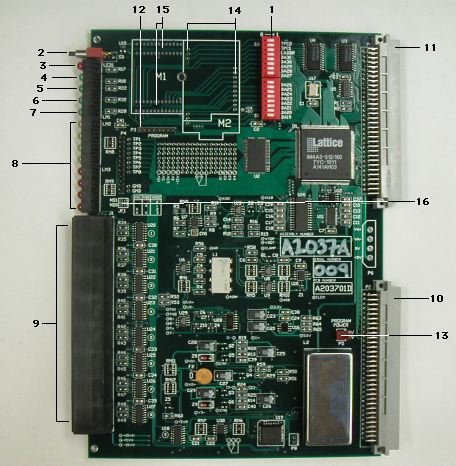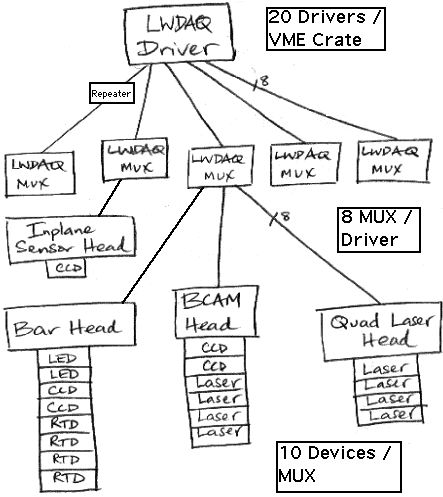
DAQ controlled by surface computer.
Image analysis in surface computer.
Two DAQ processes: one per end cap.
End-Cap Alignment Data Acquisition
Kevan Hashemi
Muon Calibration and Alignment Workshop
15th February 2005
Ringberg Castle, Germany
USA15-to-Surface Architecture

DAQ controlled by surface computer.
Image analysis in surface computer.
Two DAQ processes: one per end cap.
ATLAS LWDAQ Driver
LWDAQ Driver (A2037A) with VME Interface
6U VME card
8 LWDAQ root sockets
Digitizes images at 2 Mpixels/s
Device-to-Crate Architecture
Repeaters:
Integrated into patch panels
Switch mux and device power on and off
Increase max root from 130 m to 180 m
Image Acquisition Speed
Expose image sensor < 10 ms
Read out image sensor = 40 ms
Upload image to surface computer < 200 ms
Analyze image in surface computer < 50 ms
Serial image capture and processing time
< 300 ms
Slowest step is upload to surface:
Through VME-TCPIP Board
Current version 170 kBytes/s
Next version > 400 kBytes/s
Each image 80 KBytes
The VME-TCPIP Board:
Made by Brandeis University
Compatible with our LWDAQ Software
Costs < $500 (CERN version $5000)
End-Cap Cycle Time
With single-spot BCAM images:
For each laser
Viewed by each BCAM
We need one image
For each RASNIK
We need one image
For each Proximity Camera
We need one image
No EE chambers
number of images per end-cap
< 5000
cycle time per end-cap
< 30 minutes
our target has always been
< 15 minutes
Proposed Interface to
Surface Computers
Surface computers run LWDAQ software.
LWDAQ provides instruments:
BCAM, RASNIK, Thermometer
LWDAQ runs its Acquisifier tool.
Acquisifier runs an acquisifier script.
Acquisifier script is a sequence of steps.
Each step can:
cause an instrument acquisition
configure the acquisifier
store raw data to disk
transmit data over TCP/IP
Acquisifier can be controlled by TCP/IP.
Acquisifer can transmit output by TCP/IP
Multiplexer Power Control
One execution of a script is a cycle.
Repeaters in root cables allow us to turn off power to multiplexers.
Turning off power improves radiation resistance.
Multiplexers in high-radiation areas will have repeaters in their root cables.
Acquisifier maps out multiplexer use during cycle prior to execution.
Acquisifier turns on power to multiplexers the step before they are needed.
Acquisifer turns off power to multiplexers when they are not needed.
Step Execution
LWDAQ Instruments:
try to acquire valid data
adjust certain DAQ parameters
recognise bad data
abort on time-outs
analyse valid data
always return results string
A DAQ step in an Acquisifier script:
configures a LWDAQ instrument
acquires data with instrument
can store raw data to disk
produces an output string
The step output is another step.
The cycle output is another cycle.
The next cycle script is the output of the current cycle.
Example DAQ Step with Output
An Acquisifier DAQ step:
acquire:
name: BCAM_1_2
instrument: BCAM
result: "None"
config:
daq_flash_seconds "0.000010"
daq_sensor_driver_socket "5"
daq_sensor_element "2"
daq_source_element "3 4"
daq_source_driver_socket "8"
end.
An example output:
acquire:
name: BCAM_1_2
instrument: BCAM
result: "BCAM_56 2047.85 1175.21 16 130 0.006 36"
config:
daq_flash_seconds "0.000025"
daq_sensor_driver_socket "5"
daq_sensor_element "2"
daq_source_element "3 4"
daq_source_driver_socket "8"
end.
Note result and flash time.
Acquisifier Operation
Acquisifier can be controlled over TCP/IP.
Stop execution
Send new script
Configure output transmission
Configure local data storage
Configure cycle timing
Transmit status report
Transmit current script
When running continously:
Modifies its script during cycle
Stores script at end of cycle
Transmits script at end of cycle
(script contains results)
Maintains list of steps returning errors
Listens for instructions after each step
Acquisifier never aborts script execution.
Acquisifier records errors and warnings.
The Current Acquisifer
The LWDAQ software now provides an Acquisifier tool.
Current Acquisifier is not fully functional:
TCP/IP control not implemented
Error reporting not implemented
Raw data storage not implemented
But the basic operational structure exists.
Working well on systems with a dozen instruments.
Should work on systems with thousands of instruments.
Connection to Conditions Database
Acquisifer output is an Acquisifier script:
contains all data acquisition paramters
contains all results
We can provide a TCL/TK tool that extracts results from script.
ARAMYs takes text files as input.
We foresee no difficulties communicating between the Acquisifier and ARAMYs.
We ask that the Acquisifer scripts be stored in the conditions database.
The script for each end-cap will be 5000 steps long, roughly 1 MByte.
Need 2 MBytes/hr for each end-cap.
Conclusion
ATLAS DAQ program is the Acquisifier tool provided by our LWDAQ software.
Will set up VME-TCPIP boards, repeaters, and prototype Acquisifier at CERN soon.
Output from Alignment system is a text file containing results and DAQ parameters.
Each end-cap produces one such text file per half-hour.
Each end-cap requires 2 MBytes/hr storage in conditions database.
To Do: translation of these text files into format readable by ARAMYs.
To Do: add features to Acquisifier.